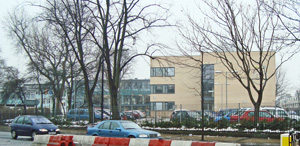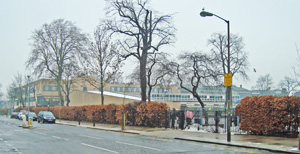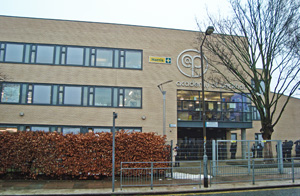Peckham House
112 High Street, Peckham, SE15 5DZ
Medical
dates:
Medical
character:
Mental (Licensed House)
In 1826 Charles Mott established
Peckham House, an 18th century house in seven acres of grounds, as a
Licensed House (a private asylum). Additional accommodation was
built in the grounds and several outhouses were converted into wards.
The asylum was contracted to take pauper lunatics from Lambeth and forty other parishes. It also admitted private patients.
In 1828 it contained 130 patients.
In 1829 the joint proprietors of the asylum were Charles Mott, George John Taylor and Dr Peter Armstrong, under the name of Charles Mott & Co. Dr Armstrong was the Resident Superintendent, while his wife was the Matron.
In 1831 the asylum contained 250 patients - 201 pauper and 49 private. In 1833 it was licensed for 172 paupers and 48 private patients.
In 1834 Charles Mott was appointed as a Poor Law Commissioner and retired from the asylum. His place was taken by E. Hould and the partnership of Charles Mott & Co. was dissolved. It was replaced by Peter Armstrong & Co., consisting of Dr Peter Armstrong, George John Taylor and E. Hould.
When the new Surrey County Lunatic Asylum opened in 1841, some 172 pauper patients were transferred there.
In 1844 the asylum was licensed to Dr Armstrong. It accommodated 251 patients - 203 pauper and 48 private. The weekly charge for a pauper was 10 shillings (50p), including maintenance, medicine and clothing. The Commissioners in Lunacy found the patient accommodation to be good. However, they were so concerned about the paupers' meagre diet, about which they had complained before, that they considered withholding the license.
In October 1848 it was the first private asylum to experience an outbreak of cholera (subsequently Camberwell House and Grove Hall also had outbreaks). The patients were treated initially with brandy and capsicum, then with the inhalation of chloroform for about 15 minutes, which proved rather successful. Of the 54 cases, 38 recovered and 16 died.
During their visit in 1851, the Commissioners in Lunacy found the asylum to be somewhat unsatisfactory. It accommodation was made of blocks of different character - some old but beyond patching, some modernised, and a few in good condition. Many of the single rooms were badly lit and some were even like prison cells. The pauper lunatics were not well supplied with washing equipment, and there were too few towels. The ratio of male attendants was one to every seven patients and, of the female attendants, one to every nine patients.
In 1855 cholera broke out again. The outbreak lasted for 72 days.
In 1858 there were 366 patients - 317 pauper and 49 private.
In 1859 Dr Henry Armstrong took over the license from his father Peter; Mr Samuel Morris, a surgeon, became a co-licensee. The asylum contained 367 inmates - 317 pauper (129 male, 188 female) and 50 private (16 male, 34 female).
In 1867 the Commissioners in Lunacy found conditions for the patients to be more favourable than previously.
In 1872 the asylum was purchased from Dr Armstrong by Dr Alonzo Henry Stocker (1830-1910). It was jointly licensed to Dr Stocker and Mr E.H. Byas, who both also ran Grove Hall in Bow (Dr Stocker also acquired Northumberland House in Finsbury Park in 1877). Dr Stocker was assisted by Dr Brown as Medical Superintendent and Dr Barringer as Medical Officer.
In November 1873 the main house caught fire. Following this, over a two year period, Dr Stocker made substantial alterations to the building, and a lodge was added by the main entrance gates. He also purchased Craigweil House, a large mansion with a lodge and grounds in Bognor Regis, for use as a seaside convalescent home for the patients. Patients from Northumberland House were also able to enjoy holidays there. (It closed in 1910 and was sold when Dr Stocker died.)
In 1874 the asylum contained 352 patients - 180 pauper (66 male, 114 female) and 173 private (48 male, 125 female). The weekly charge for a pauper was 17 shillings and 6 pence (87p), while most private patients paid from one to one-and-a-half guineas (£1.05 - (£1.57). The private patients lived in better accommodation in separate blocks to the paupers. Their rooms were light and cheerful, heated by fires and the bathrooms plentifully supplied with hot and cold water; there was a bagatelle table for indoor amusement. They had their own separate garden. In the more expensive private accommodation where the apartments were far superior, with every comfort offered, 42 female patients, much further up the social scale, were charged fees of 5 guineas (£5.25) a week.
By 1882 the asylum was one of only five Licensed Houses remaining in the Metropolitan District to which paupers were admitted - the others were Bethnal House, Camberwell House, Hoxton House and Grove Hall.
In 1882 the asylum was licensed for 375 patients to Mr Byas and Dr Stocker. The latter, together with Dr Brown, were in joint medical charge with two assistants.
In May of that year there was an outbreak of smallpox.
In November 1882 the asylum contained 358 patients, of whom 114 were paupers (the charges for private patients were only slightly higher than those for the paupers). The Commissioners in Lunacy found the day rooms, dormitories and single rooms to be in good order, clean and 'free from offensive smell', but found fault with the insufficient teasing of flock beds and pillows. Some structural improvements had been carried out on the buildings and more were planned, especially to create more day-space in a few of the wards. The lady companions for the female patients, which the Commissioners had earlier recommended, had been added to the staff and a pay increase was planned for the attendants.
It is likely that no more pauper lunatics were admitted after the county asylums had been built. Between 1885 and 1902 the asylum admitted 'imbecile' patients from Westminster.
By 1912 the lowest weekly charge for a private patient was 30 shillings (£1.50).
In 1914 Dr Frank Raymond King was appointed as Medical Superintendent.
In 1919 the joint licensees were Dr Alonzo Harold Stocker and Hubert Goodman Stocker, the sons of Alonzo Henry Stocker.
In 1927 Kearnsey Court in Kent was purchased for use as a convalescent home, to be shared with Northumberland House.
Shortly before the outbreak of WW2, Dr King resigned in July 1939 and was replaced by Dr Kennedy (who left during the Blitz). The asylum continued to be run by Joyce (Heywood) Stocker, the wife of Dr Rupert Stocker (son of Alonzo Harold Stocker), with Dr Phillip Edward Frossard as Medical Superintendent. A few patients remained during the war. The asylum received some damage from incendiary bombs, but otherwise survived fairly intact.
In 1944 the weekly charge was three-and-a-half guineas (£3.67). Patients suffered from nervous and mental illness, as well as alcohol and drug dependency.
In March 1951 the license was issued to Alan Francis Grimbly, but later in the year the asylum closed as the owner, Dr Rupert Stocker, had to pay particularly heavy death duties.
The asylum was contracted to take pauper lunatics from Lambeth and forty other parishes. It also admitted private patients.
In 1828 it contained 130 patients.
In 1829 the joint proprietors of the asylum were Charles Mott, George John Taylor and Dr Peter Armstrong, under the name of Charles Mott & Co. Dr Armstrong was the Resident Superintendent, while his wife was the Matron.
In 1831 the asylum contained 250 patients - 201 pauper and 49 private. In 1833 it was licensed for 172 paupers and 48 private patients.
In 1834 Charles Mott was appointed as a Poor Law Commissioner and retired from the asylum. His place was taken by E. Hould and the partnership of Charles Mott & Co. was dissolved. It was replaced by Peter Armstrong & Co., consisting of Dr Peter Armstrong, George John Taylor and E. Hould.
When the new Surrey County Lunatic Asylum opened in 1841, some 172 pauper patients were transferred there.
In 1844 the asylum was licensed to Dr Armstrong. It accommodated 251 patients - 203 pauper and 48 private. The weekly charge for a pauper was 10 shillings (50p), including maintenance, medicine and clothing. The Commissioners in Lunacy found the patient accommodation to be good. However, they were so concerned about the paupers' meagre diet, about which they had complained before, that they considered withholding the license.
In October 1848 it was the first private asylum to experience an outbreak of cholera (subsequently Camberwell House and Grove Hall also had outbreaks). The patients were treated initially with brandy and capsicum, then with the inhalation of chloroform for about 15 minutes, which proved rather successful. Of the 54 cases, 38 recovered and 16 died.
During their visit in 1851, the Commissioners in Lunacy found the asylum to be somewhat unsatisfactory. It accommodation was made of blocks of different character - some old but beyond patching, some modernised, and a few in good condition. Many of the single rooms were badly lit and some were even like prison cells. The pauper lunatics were not well supplied with washing equipment, and there were too few towels. The ratio of male attendants was one to every seven patients and, of the female attendants, one to every nine patients.
In 1855 cholera broke out again. The outbreak lasted for 72 days.
In 1858 there were 366 patients - 317 pauper and 49 private.
In 1859 Dr Henry Armstrong took over the license from his father Peter; Mr Samuel Morris, a surgeon, became a co-licensee. The asylum contained 367 inmates - 317 pauper (129 male, 188 female) and 50 private (16 male, 34 female).
In 1867 the Commissioners in Lunacy found conditions for the patients to be more favourable than previously.
In 1872 the asylum was purchased from Dr Armstrong by Dr Alonzo Henry Stocker (1830-1910). It was jointly licensed to Dr Stocker and Mr E.H. Byas, who both also ran Grove Hall in Bow (Dr Stocker also acquired Northumberland House in Finsbury Park in 1877). Dr Stocker was assisted by Dr Brown as Medical Superintendent and Dr Barringer as Medical Officer.
In November 1873 the main house caught fire. Following this, over a two year period, Dr Stocker made substantial alterations to the building, and a lodge was added by the main entrance gates. He also purchased Craigweil House, a large mansion with a lodge and grounds in Bognor Regis, for use as a seaside convalescent home for the patients. Patients from Northumberland House were also able to enjoy holidays there. (It closed in 1910 and was sold when Dr Stocker died.)
In 1874 the asylum contained 352 patients - 180 pauper (66 male, 114 female) and 173 private (48 male, 125 female). The weekly charge for a pauper was 17 shillings and 6 pence (87p), while most private patients paid from one to one-and-a-half guineas (£1.05 - (£1.57). The private patients lived in better accommodation in separate blocks to the paupers. Their rooms were light and cheerful, heated by fires and the bathrooms plentifully supplied with hot and cold water; there was a bagatelle table for indoor amusement. They had their own separate garden. In the more expensive private accommodation where the apartments were far superior, with every comfort offered, 42 female patients, much further up the social scale, were charged fees of 5 guineas (£5.25) a week.
By 1882 the asylum was one of only five Licensed Houses remaining in the Metropolitan District to which paupers were admitted - the others were Bethnal House, Camberwell House, Hoxton House and Grove Hall.
In 1882 the asylum was licensed for 375 patients to Mr Byas and Dr Stocker. The latter, together with Dr Brown, were in joint medical charge with two assistants.
In May of that year there was an outbreak of smallpox.
In November 1882 the asylum contained 358 patients, of whom 114 were paupers (the charges for private patients were only slightly higher than those for the paupers). The Commissioners in Lunacy found the day rooms, dormitories and single rooms to be in good order, clean and 'free from offensive smell', but found fault with the insufficient teasing of flock beds and pillows. Some structural improvements had been carried out on the buildings and more were planned, especially to create more day-space in a few of the wards. The lady companions for the female patients, which the Commissioners had earlier recommended, had been added to the staff and a pay increase was planned for the attendants.
It is likely that no more pauper lunatics were admitted after the county asylums had been built. Between 1885 and 1902 the asylum admitted 'imbecile' patients from Westminster.
By 1912 the lowest weekly charge for a private patient was 30 shillings (£1.50).
In 1914 Dr Frank Raymond King was appointed as Medical Superintendent.
In 1919 the joint licensees were Dr Alonzo Harold Stocker and Hubert Goodman Stocker, the sons of Alonzo Henry Stocker.
In 1927 Kearnsey Court in Kent was purchased for use as a convalescent home, to be shared with Northumberland House.
Shortly before the outbreak of WW2, Dr King resigned in July 1939 and was replaced by Dr Kennedy (who left during the Blitz). The asylum continued to be run by Joyce (Heywood) Stocker, the wife of Dr Rupert Stocker (son of Alonzo Harold Stocker), with Dr Phillip Edward Frossard as Medical Superintendent. A few patients remained during the war. The asylum received some damage from incendiary bombs, but otherwise survived fairly intact.
In 1944 the weekly charge was three-and-a-half guineas (£3.67). Patients suffered from nervous and mental illness, as well as alcohol and drug dependency.
In March 1951 the license was issued to Alan Francis Grimbly, but later in the year the asylum closed as the owner, Dr Rupert Stocker, had to pay particularly heavy death duties.
Present status (February 2009)
Dr Stocker sold the site to the Council and emigrated to Newfoundland, Canada. The asylum buildings were demolished in 1954 and a school built on their site.
The site is currently occupied by the Harris Academy at Peckham.

The Aacdemy is on the corner of Peckham Road and Lyndhurst Way.

Looking north along Lyndhurst Way.

The student entrance on Lyndhurst Way.
(Author unstated) 1834 Untitled. London Gazette 2, 1980.
(Author unstated) 1849 Critical Digest of the British and Foreign Medical Journals. Cholera. London Journal of Medicine 1 (4), 362-363.
(Author unstated) 1854 Cholera in Lunatic Asylums. Asylum Journal of Mental Science 1 (8), 131-135.
(Author unstated) 1882 Thirty-sixth Report of the Commissioners in Lunacy to the Lord Chancellor. Parliamentary Papers, 32. London, The House of Commons.
(Author unstated) 1887 Report of the Lancet Commission on Lunatic Asylums. Peckham House.
(Author unstated) 1910 Obituary. Dr Alonzo Henry Stocker. British Medical Journal 1 (2575), 1150.
Cormack, Semple 1851 Mortality in the London Hospitals. The Hospitals of London - No. VI. London Journal of Medicine 3 (30), 582-583.
Green DR 2010 Pauper Capital: London and the Poor Law, 1790-1870. Farnham, Ashgate Publishing.
http://dhgeneaology.blogspot.co.uk
http://forbears.co.uk
http://studymore.org.uk
https://en.wikipedia.org
https://research-information.bristol.ac.uk
www.alphabetthreat.co.uk
www.british-history.ac.uk
www.ennever.com (1)
www.ennever.com (2)
www.ennever.com (3)
www.nickelinthemachine.com
www.peckhamsociety.org.uk
www.threecountiesasylum.co.uk
www.wessexarch.co.uk
www.whistlestop.co.uk
Return to alphabetical list
Return to home page